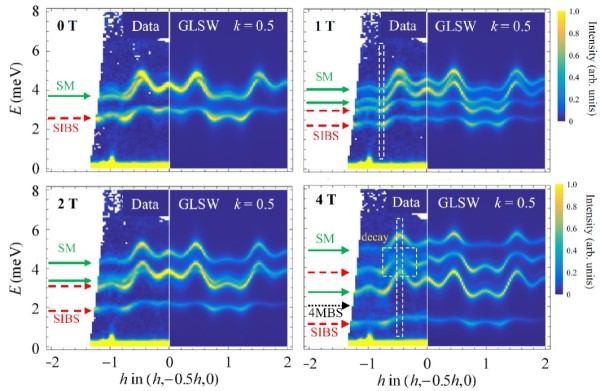Instabilities of Heavy Magnons in an Anisotropic Magnet
October 23, 2023

Inelastic neutron scattering data and GLSW calculations in magnetic fields of 0, 1, 2 and 4 T. At low fields, the spectrum consists of single magnon (SM) and single-ion bound state (SIBS) heavy magnons. The arrows show field dependent mode splitting. At 4 T, broadened scattering indicates magnon decay (the yellow dashed box) and a super heavy four-magnon bound state (4MBS) emerges.
Scientific Achievement
Magnetic fields applied to FeI2 are found to induce spontaneous decay between conventional and heavy magnons and recombination of these quasiparticles into a super heavy bound state.
Significance and Impact
The unique quantum magnon dynamics observed challenges the conventional view that compounds with large spin and large uniaxial anisotropy behave classically.
Research Details
- The magnetic excitation spectra were measured with magnetic fields applied normal to the triangular planes.
- Data are compared with SU(3) generalized linear spin wave (GLSW) theory calculations. The observed behavior is attributed to the quasi-flat nature of the excitations and the presence of anisotropic Kitaev interactions.
“Instabilities of heavy magnons in an anisotropic magnet,”
Xiaojian Bai, Shang-Shun Zhang, Hao Zhang, Zhiling Dun, W. Adam Phelan, V. Ovidiu Garlea, Martin Mourigal and Cristian Batista,
Nature Communications 14, 4199 (2023). DOI: https://doi.org/10.1038/s41467-023-39940-1




